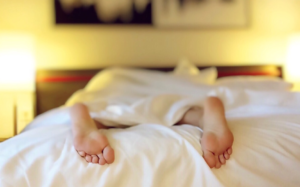You know that getting enough sound, quality sleep is a critically important aspect of your life. We need to fuel our bodies well for example with good quality supplements such as those from Gold Bee Online Store. However, did you know that your sleeping position can either negatively or positively affect your health and the quality of your sleep? Whether you want it or not, sleep dictates how conscious, happy, positive, and products you might be during the day.
Getting at least one bad sleep can literally ruin your whole week, not only a day. Unfortunately, the majority of people fail to get enough sleep. Moreover, their sleeping position might not be the best one for their health. The way you sleep can drastically impact your well-being – both medically and psychologically. Generally, there are a few factors to consider before you go to bed: from frequency, length to depth and quality. What you’re more likely to ignore though is your sleeping positioning.
How often do you wake up in the morning with a backache, a cricked neck, and heartburn? Do you wake up feeling exhausted and sleepy or refreshed and alert? Multiple studies have shown that a sleeping position is usually to blame. Every one of us has our own preferred sleeping position, which helps us feel comfortable while we sleep. Although that position might feel natural, it might not be healthy. Check out four sleeping positions below and learn which one is the best for your health.
Sleeping on your side
One of the best sleeping positions, side sleeping is ideal for your digestion, particularly if you tend to sleep on the left side. Sleeping on the left side improves blood flow body-wide. The spine is still elongated in this sleeping position, and if you snore, it can reduce your snoring to the minimum. If you’re pregnant, your doctor will tell you that you should learn to sleep on your side, as it improves blood circulation to the fetus.
Side sleeping has its drawbacks, though. First of all, all that whole-night face smashing results in facial acne, fine lines, and premature wrinkles. If you suffer from acne and sleep on your side, ensure you change your pillowcase regularly and keep your hair clean. You can ward off fine lines and premature minimize wrinkles by sleeping on a pillowcase, which is e made of smooth material, such as satin or silk to decrease friction.
Side sleepers typically don’t have trouble falling asleep. Sleeping on the side isn’t recommended for women with large breasts, too. Side sleepers should sleep on a thick pillow to fill the space above the shoulder and support the neck and head in a neutral position.
Sleeping on your back
Sleeping on the back is considered to be the best position for reducing pressure on the spine and thus ease and prevent back pain. When you sleep on your back, it helps you to keep your back and neck relaxed and in a light alignment. Sleeping on your back can reduce the likelihood of breakouts and acne as well as premature wrinkles and fine lines, as your face doesn’t touch your pillow.
Women with big breasts can reap the benefits of back sleeping, too. This sleeping position supports the breasts and wards of their sagging. The bad news for snorers, though. If you snore, it’s best to avoid sleeping on your back. Consider the side sleeping position, instead.
Sleeping in the fetal position
With an estimated 41 per cent of people sleeping in the fetal position, it’s also one of the most popular positions for sleep. This is when you sleep on your side with your knees bent and your torso hunched. The fetal position is recommended for pregnant women and snorers. This sleeping position enhances blood flow in the mother’s body and the fetus, preventing the uterus from putting pressure on the liver that’s located on the right side. Sleeping in the fetal position has its drawbacks, too. For instance, if you sleep tightly curled up, it can negatively affect your breathing in the diaphragm. If you suffer from arthritis in your back or joints, sleeping in the fetal position can make you feel a little sore when you wake up in the morning.
Rather than pull your knees up high and tuck the chin into the chest, straighten out your body as frequent as you can during the night. Or, place a pillow between your knees to relieve strain on the hips. Moreover, make sure you sleep on a plump pillow to support your neck and head.
Sleeping on your stomach
The most comfortable sleeping position for a great number of people, stomach sleeping is actually the worst way to enjoy your sleep. However, this position aids in preventing snoring. In case you suffer from a dangerous condition like sleep apnea, sleeping on your stomach might be good for you. In general, stomach sleeping is bad for your neck, back, breasts, and face.
Sleeping on your belly each night can result in nerve irritation in the neck, especially if you sleep on a thick pillow with your neck being at a sharp angle. Over time, this habit will lead to chronic neck pain, numbness, and tingling. If you have trouble falling asleep and any other sleeping position except a stomach one make you feel comfortable, consider sleeping on a natural latex mattress and a stomach sleep pillow. You need to get the whole-body support to ease pressure on your body and prevent the pain triggered by stomach sleeping.
Despite the fact that it’s impossible to change the sleeping position, it’s still possible to do it. Consider gradually including the first three sleeping positions in your pre-sleep time. You might feel uncomfortable at first, but don’t give up. Allow your body to adjust to those positions. There are also a lot of devices and pillows and mattresses that help to learn how to sleep correctly. If you still can’t teach yourself to sleep in a healthy position, use pillows to reduce the negative effect of bad sleeping positions.



No Comments